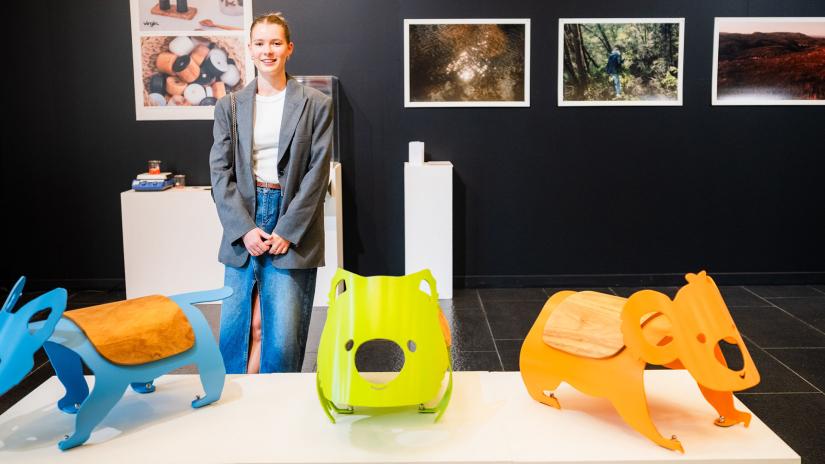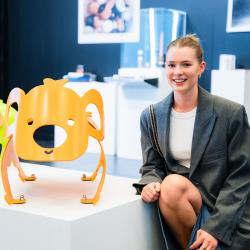Luisa Skyring
The product design graduate is advocating for First Nations inclusion through design.

Luisa Skyring’s product design career was going from strength to strength when she applied for the UTS Design Honours program.
She’d just completed her Bachelor of Design in Product Design and had spent six months working at mili mili, a First Nations-led public art consultancy with a focus on creating meaningful public spaces.
But even though she had the option of throwing herself fully into her working life, she wasn’t quite ready to move on from UTS.
I really enjoyed learning and I liked being at uni and I wanted to keep educating myself further. I also wanted to [create] a project that I was really passionate about. I think that honours really gives that to anyone, even if you already have a job.
Gap in the market
Over 12 months, Luisa collaborated with mili mili Co-founder and Creative Director Nicole Monks to produce jinjamarda, a playful street furniture collection for children. jinjamarda is a Wajarri word that means ‘little brother, little sister’.
Each piece of jinjamarda represents a native or endemic Australian animal to Awabakal Country (Newcastle) and acts as a physical play object and educational opportunity all in one.
The project addresses an underserved market — “we saw a gap in street furniture — children are ignored a little bit in the street furniture space,” Luisa says — but it also advocates for the inclusion of First Nations perspectives in contemporary product design processes.
“We created jinjamarda based on mili mili’s culturally aware design methodology, which raises awareness of First Nations rights and connection to Country,” Luisa says.
“It was designed as an example of how this design methodology should be promoted in the wider industrial design industry — that First Nations inclusion should be the standard.
“The actual project is more about what the work teaches you than what you actually see when you look at it.”
Showcasing jinjamarda

jinjamarda was unveiled at the 2023 Design Honours Showcase, an exhibition of final-year projects from across the UTS School of Design.
The event, which is open to design industry professionals, as well as to students’ families and friends, is a celebration of the 12 months of effort students invest in bringing their projects to life. Product design companies who attended this year’s showcase included Vert Industrial Design House, Tilt Industrial Design, Nielsen Design and Industrial Design Exchange.
It’s also an opportunity for students to reflect on the entirety of their UTS experience. For Luisa, the first couple of years of study were marred by COVID-19 restrictions, which saw her studying product design from her bedroom.
But as the restrictions lifted and life returned to normal, she started building hands-on skills that have already proved vital to her real-life product design practice. These include 3D printing and CAD drawing.
“With CAD, I didn’t enjoy it at first, but I see the benefits now in terms of fabrication and manufacturing,” she says.
As the undergrad degree progressed, Luisa’s confidence grew, which in turn led to her to apply for work at mili mili. Her role, which she’s now been in for over a year, has been the practical expression of her product design expertise — but it’s been more than that, too.
Luisa works in a team with Nicole, a Yamaji Wajarri woman with Dutch and English heritage, and Colin Ryan, the company’s Technical Director. Both Nicole and Colin have supported Luisa’s professional growth.
Not only did they rearrange her work schedule to help her complete her Honours degree, but they introduced her to industry contacts and collaborated on bringing jinjamarda to life. The result is a project that will be part of mili mili’s portfolio.
“Producing this project gave me more confidence as well as a design that works, or that I could work on successful designs in the future and I can pitch them to clients or to mili mili,” Luisa says.
Future plans
Next, she’d like to take the work out of the academic environment in which it was created and into the big wide world.
“The next step would be to go to communities and say, ‘What do you need?’ and get Aboriginal Community members involved in the project, rather than going to an architect and saying, ‘Let’s just put that in a park and see what people do with it’,” Luisa says.
“I’ve definitely learnt how important it is to consider who’s involved in the design and who should be involved as well.”
Luisa was mentored through her Honours project by Rod Walden and Dr Stefan Lie.
